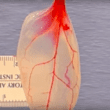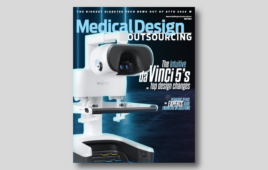
A portion of a donated human heart is kept alive and beating in a laboratory at The Ohio State University Wexner Medical Center. Researchers reanimate the heart to look for hidden sources of irregular heartbeats. [Image from Ohio State]
“It’s amazing. You can see the heart start beating again, which gives us an opportunity to study it with high-speed, high-tech equipment,” said Vadim Fedorov, an OSU biologist who developed the technique, in a press release. “This allows us to see the heart in 3D and search for sources of irregular beats that we’ve never been able to find.”
The hearts were donated from patients who were set to receive a new heart. The researchers used the top part of the heart, the atria, and placed them in a dish that had 4 high-speed optical cameras around it. The tissues were reanimated for 12 hours and injected with a dye that detects electrical signals.
Reanimating human hearts is nothing new. For example, the Visible Heart Lab at the University of Minnesota has reanimated dozens of donated hearts since the late 1990s. The OSU researchers, however, think their works with reanimated hearts is an improvement.
“Normal imaging techniques give us 100 to 200 recordings of the heart,” said Fedorov. “These cameras are able to give us 40,000 recordings, all in 3D.”
Patients who have atrial fibrillation have an irregular heartbeat throughout the day, making it difficult for doctors to perform ablations on small areas of the heart. Using the images, researchers can map out sections of the heart to perform cardiac ablations. Scar tissues created during an ablation procedure can disrupt electrical signals of the heart and stop irregular heartbeats, according to the researchers.
“This will allow us to map the heart more completely and eventually may help us personalize our procedures according to each patient’s individual needs,” said John Hummel, director of clinical electrophysiology research at OSU’s Wexner Medical Center. “While it’s still in the early stages, the work Dr. Fedorov is doing with human heart tissue is the kind of thing that will make pivotal changes in our ability to manage patients’ diseases in the coming years.”
[Want to stay more on top of MDO content? Subscribe to our weekly e-newsletter.]







